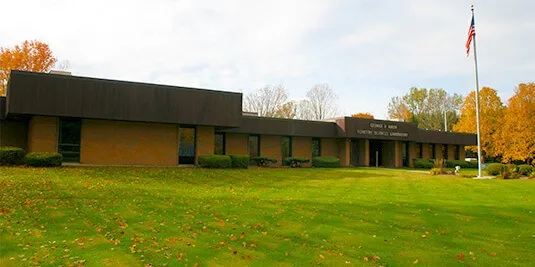The lab facility shares the “George D. Aiken” name with the School's main campus building, the George D. Aiken Center. Research at the Forestry Sciences Lab includes ecosystem and forest ecology, tree physiology, soil biogeochemistry, ecological design, and entomology.
Facilities
The Forestry Sciences Lab facility includes three buildings and the surrounding property to support the Rubenstein School’s research. The land is contiguous with the UVM Bio-Research complex to the north. The main building contains laboratories and offices. The headhouse/greenhouse and large barn are located behind (southwest) of the main building. The property supports several ongoing field research projects, offers space for future experimental use, and is the site of two arrays of photovoltaic cells (solar panels) that generate power for the Rubenstein School. The 17 solar trackers produce over 100,000 kilowatt-hours of electricity annually to offset energy usage in the Aiken Center on the main campus.
Laboratories within the facility offer a wide range of research capabilities. Equipment includes: walk-in freezer and refrigerator; -80˚C freezer; Shimadzu GC-2014 greenhouse gas analyzer; elemental analyzer; Fourier transform infrared spectroscopy; drying ovens; a tree ring laboratory; plant cold tolerance testing equipment; microscopes; and other basic laboratory equipment.

History and Partners
The facility was built in 1973 on 12 acres to house the United States Forest Service Northeastern Forest Experiment Station. In the early years, Forest Service scientists focused their research on sugar maple trees and maple sap and syrup production, as noted by the maple interior wall paneling and flooring, as well as the landscape maple trees. Beginning in 1982, Forest Service research shifted to a broad range of topics including forest health, silvicultural management and decision support, and recreation management. A notable accomplishment of this work was the identification of the mechanism through which acid deposition predisposes sensitive tree species to damage—an achievement attained through close cooperation with Rubenstein School scientists.
In 2013, the facility was transferred to the University of Vermont through a collaboration between the U.S. Forest Service and the Rubenstein School. The building now houses a unique combination of partners including the Rubenstein School, US Forest Service Northern Research Station, the Forest Ecosystem Monitoring Cooperative, the American Chestnut Foundation, and Lake Champlain Sea Grant.
Contact Us
Associate Professor, Rubenstein School • Faculty Fellow, Gund Institute for Environment • Director, Aiken Forestry Sciences Laboratory
carol.adair@uvm.edu (802) 656-2907Forestry Sciences Laboratory Manager • Senior Lab Research Technician
maxwell.landsman-gerjoi@uvm.edu (802) 656-8278